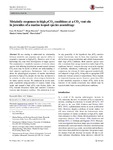Metabolic responses to high pCO2 conditions at a CO2 vent site in juveniles of a marine isopod species assemblage
| dc.contributor.author | Turner, Lucy | |
| dc.contributor.author | Ricevuto, E | |
| dc.contributor.author | Massa Gallucci, A | |
| dc.contributor.author | Lorenti, M | |
| dc.contributor.author | Gambi, M-C | |
| dc.contributor.author | Calosi, P | |
| dc.date.accessioned | 2016-10-28T07:07:21Z | |
| dc.date.available | 2016-10-28T07:07:21Z | |
| dc.date.issued | 2016-10 | |
| dc.identifier.issn | 0025-3162 | |
| dc.identifier.issn | 1432-1793 | |
| dc.identifier.other | 211 | |
| dc.identifier.uri | http://hdl.handle.net/10026.1/6660 | |
| dc.description.abstract |
We are starting to understand the relationship between metabolic rate responses and species' ability to respond to exposure to high pCO2. However, most of our knowledge has come from investigations of single species. The examination of metabolic responses of closely related species with differing distributions around natural elevated CO2 areas may be useful to inform our understanding of their adaptive significance. Furthermore, little is known about the physiological responses of marine invertebrate juveniles to high pCO2, despite the fact they are known to be sensitive to other stressors, often acting as bottlenecks for future species success. We conducted an in situ transplant experiment using juveniles of isopods found living inside and around a high pCO2 vent (Ischia, Italy): the CO2 'tolerant' Dynamene bifida and 'sensitive' Cymodoce truncata and Dynamene torelliae. This allowed us to test for any generality of the hypothesis that pCO2 sensitive marine invertebrates may be those that experience trade-offs between energy metabolism and cellular homoeostasis under high pCO2 conditions. Both sensitive species were able to maintain their energy metabolism under high pCO2 conditions, but in C. truncata this may occur at the expense of [carbonic anhydrase], confirming our hypothesis. By comparison, the tolerant D. bifida appeared metabolically well adapted to high pCO2, being able to upregulate ATP production without recourse to anaerobiosis. These isopods are important keystone species; however, given they differ in their metabolic responses to future pCO2, shifts in the structure of the marine ecosystems they inhabit may be expected under future ocean acidification conditions. | |
| dc.format.extent | 211- | |
| dc.format.medium | Print-Electronic | |
| dc.language | en | |
| dc.language.iso | en | |
| dc.publisher | Springer Science and Business Media LLC | |
| dc.subject | 14 Life Below Water | |
| dc.title | Metabolic responses to high pCO2 conditions at a CO2 vent site in juveniles of a marine isopod species assemblage | |
| dc.type | journal-article | |
| dc.type | Journal Article | |
| plymouth.author-url | https://www.webofscience.com/api/gateway?GWVersion=2&SrcApp=PARTNER_APP&SrcAuth=LinksAMR&KeyUT=WOS:000386356100015&DestLinkType=FullRecord&DestApp=ALL_WOS&UsrCustomerID=11bb513d99f797142bcfeffcc58ea008 | |
| plymouth.issue | 10 | |
| plymouth.volume | 163 | |
| plymouth.publication-status | Published | |
| plymouth.journal | Marine Biology | |
| dc.identifier.doi | 10.1007/s00227-016-2984-x | |
| plymouth.organisational-group | /Plymouth | |
| plymouth.organisational-group | /Plymouth/Faculty of Science and Engineering | |
| plymouth.organisational-group | /Plymouth/Faculty of Science and Engineering/School of Biological and Marine Sciences | |
| plymouth.organisational-group | /Plymouth/REF 2021 Researchers by UoA | |
| plymouth.organisational-group | /Plymouth/REF 2021 Researchers by UoA/UoA07 Earth Systems and Environmental Sciences | |
| plymouth.organisational-group | /Plymouth/Users by role | |
| plymouth.organisational-group | /Plymouth/Users by role/Academics | |
| dc.publisher.place | Germany | |
| dcterms.dateAccepted | 2016-09-06 | |
| dc.identifier.eissn | 1432-1793 | |
| dc.rights.embargoperiod | No embargo | |
| rioxxterms.funder | Natural Environment Research Council | |
| rioxxterms.identifier.project | Impacts of ocean acidification on key benthic ecosystems, communities, habitats, species and life cycles | |
| rioxxterms.versionofrecord | 10.1007/s00227-016-2984-x | |
| rioxxterms.licenseref.uri | http://www.rioxx.net/licenses/all-rights-reserved | |
| rioxxterms.licenseref.startdate | 2016-10 | |
| rioxxterms.type | Journal Article/Review | |
| plymouth.funder | Impacts of ocean acidification on key benthic ecosystems, communities, habitats, species and life cycles::Natural Environment Research Council | |
| plymouth.oa-location | https://link.springer.com/article/10.1007/s00227-016-2984-x |


